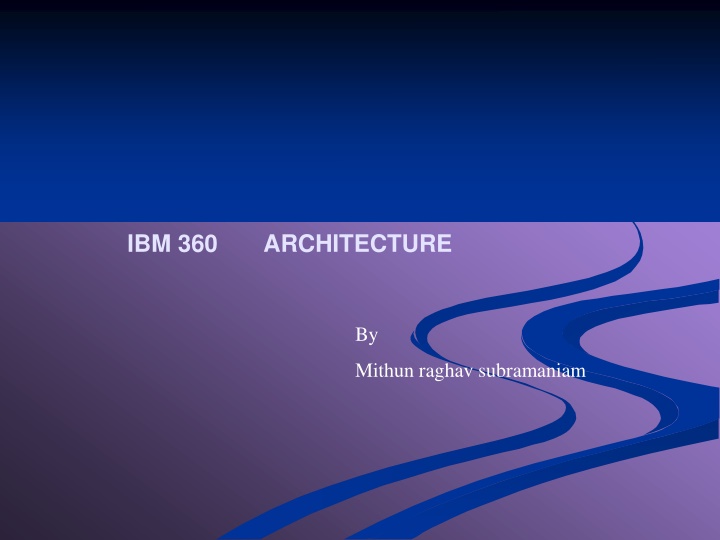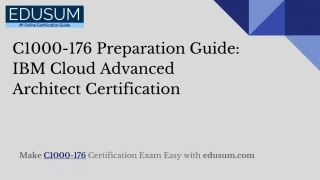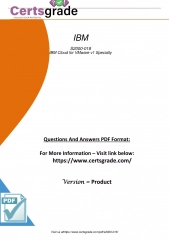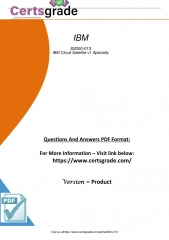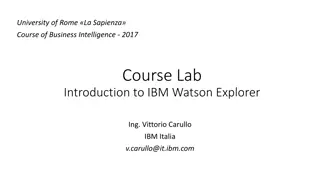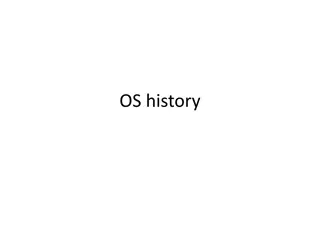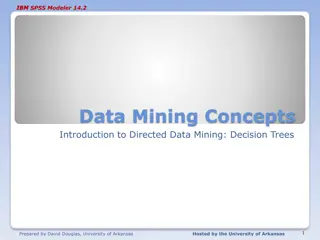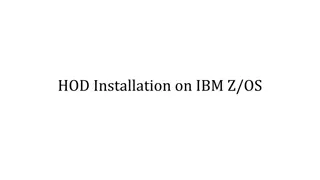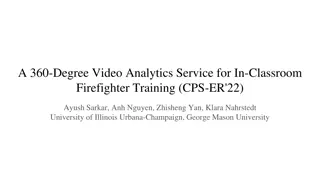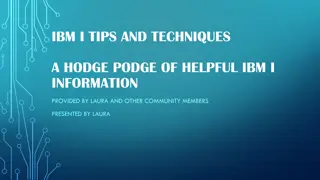IBM System/360 Architecture Evolution
The IBM System/360 (S/360) mainframe computer system family, introduced in 1964, revolutionized computing with its forward and backward compatibility, ISA family concept, and efficient integration of scientific and business applications. The critical elements, including compatibility design considerations and the evolution of instruction set architectures, shaped the foundation for future computer systems.
Download Presentation

Please find below an Image/Link to download the presentation.
The content on the website is provided AS IS for your information and personal use only. It may not be sold, licensed, or shared on other websites without obtaining consent from the author.If you encounter any issues during the download, it is possible that the publisher has removed the file from their server.
You are allowed to download the files provided on this website for personal or commercial use, subject to the condition that they are used lawfully. All files are the property of their respective owners.
The content on the website is provided AS IS for your information and personal use only. It may not be sold, licensed, or shared on other websites without obtaining consent from the author.
E N D
Presentation Transcript
IBM 360 ARCHITECTURE By Mithun raghav subramaniam
CONTENTS INTRODUCTION CRITICAL ELEMENTS ARCHITECTURE DETAILS ADDRESSING MODES AND INSTRUCTION FORMATS OPERATION ON THE 360/370
INTRODUCTION The IBM System/360 (S/360) is a mainframe computer system family announced by IBM on April 7, 1964. It was the first family of computers designed to cover the complete range of applications, from small to large, both commercial and scientific. The goal when creating the IBM 360 was to create a family concept , where for the first time a single ISA could be used with older and newer machines in the same family. The IBM 360 was historically important due to 1. forward and backward compatibility (family concept and extensive instruction set) 2. clear separation between architecture and implementation 3. integration of scientific and business efficiency 4. extensive use of microprogramming
CRITICAL ELEMENTS Forward and Backward Compatibility IBM wanted to create general purpose computers that were both forward and backward compatible. In doing so, they created small and large computers that could handle the same ISA. They had to find a middle ground between complicated and resource-intensive microinstructions that small computers couldn t run effectively and simple instructions that didn t utilize the large computers resources. The loss of efficiency in the computers due to compatibility design considerations was far overshadowed by the advantage of compatibility achieved between models. Hence, they could create software that fit a single product line and customers could choose their appropriate machine along this compatible line. The IBM 360 family of computers created the concept of the ISA , where every machine had the same set of instructions, number of user registers, and behavior, and thus were binary compatible
Evolution of Instruction Set Architectures Evolution of Instruction Set Architectures Single Accumulator (EDSAC 1950) Accumulator + Index Registers (Manchester Mark I, IBM 700 series 1953) Single Accumulator (EDSAC 1950) Accumulator + Index Registers (Manchester Mark I, IBM 700 series 1953) Separation of Programming Model from Implementation Separation of Programming Model from Implementation High-level Language Based (B5000 1963) High-level Language Based (B5000 1963) Concept of an ISA Family (IBM 360 1964) Concept of an ISA Family (IBM 360 1964) General Purpose Register (GPR) Machines General Purpose Register (GPR) Machines Load/Store Architecture (CDC 6600, Cray 1 1963-76) RISC (MIPS, SPARC, HP-PA, IBM RS6000, . . . 1987) Load/Store Architecture (CDC 6600, Cray 1 1963-76) Complex Instruction Sets (CISC) (Vax, Motorola 68000, Intel x86 1977-80) Complex Instruction Sets (CISC) (Vax, Motorola 68000, Intel x86 1977-80) RISC (MIPS, SPARC, HP-PA, IBM RS6000, . . . 1987)
Clear Separation Between Architecture and Implementation The various capabilities and resources of one computer in the line versus another required different implementations, while using the same ISA. IBM used the same architecture throughout many different computers that then needed different implementations Integration of Scientific and Business Efficiency Before the IBM 360, computers typically offered performance in either scientific or business constructs. The IBM 360 family of machines could run the same programs that were on separate computers earlier, but at different speeds. The tradeoff of performance for the ability to run business and scientific programs on the same machine was worthwhile. System/360 was designed to be able to handle both decimal and binary formatted information, with both variable-fixed length and floating- point arithmetic capabilities. Since scientific users tended to use Fortran and business users tended to use Cobol, IBM designed and developed the PL/1 programming language in a an attempt to provide a programming bridge between the two communities
Extensive Use of Microprogramming The architecture of the IBM 360 is built around microprogramming, or small programs of microinstructions. By using microprogramming, smaller and larger computers could accomplish goals of small micro programs with their own implementations and use whichever microinstructions best suited them (most efficiently, that is). This way the ISA is consistent, but separate efficient microprogramming techniques between models are the only difference. In order to accomplish this, there needs to be an extensive set of microinstructions that all of the different models of computers could use. Thus, the concept of a CISC (Complex Instruction Set Computing) architecture was created.
The 360/370 Instruction Set Architecture The IBM System/360 is a 32-bit machine with byte addressability and support for a variety of data types: byte, halfword (16 bits), word (32 bits), doubleword (double- precision real), packed decimal, and unpacked character strings. The System/360 had alignment restrictions, which were removed in the System/370 architecture. The internal state of the 360 has the following components: 1. Sixteen 32-bit, general-purpose registers: register 0 is special when used in an addressing mode, where a zero is always substituted. 2.Four double-precision (64-bit) floating-point registers. 3.Program status word (PSW) holds the PC, some control flags, and the condition codes. 4.Later versions of the architecture extended this state with additional control registers.
Addressing Modes and Instruction Formats The 360/370 has five instruction formats. Each format is associated with a single addressing mode and has a set of operations defined for that format. While some operations are defined in multiple formats, most are not. RR (register-register ) RX (register-indexed) RS (register-storage ) SI (storage-immediate) SS(storage-storage)
Operations on the 360/370 The instructions on the 360 can be divided into classes. Four basic types of operations on data are supported: 1. Logical operations on hits, character strings, and fired words. These are mostly RR and RX formats with a few RS instructions. 2. Decimal or character operations on strings of characters or decimal digits. These are SS format instructions. 3. Fixed-point binary arithmetic. This is supported in both RR and RX formats. 4. Floating-point arithmetic. This is supported primarily with RR and RX instructions. Branches use the RX instruction format with the effective address specifying the branch target. Since branches are not PC-relative, a base register may need to be loaded to specify the branch target. This has a rather substantial impact: in general, it means that there must be registers that point to every region containing a branch target. The condition codes are set by all arithmetic and logical operations. Conditional branches test the condition codes under a mask to deter-mine whether or not to branch.
IBM System z10 IBM System z10 is the latest line of IBM mainframes. The z10 Enterprise Class (EC) was announced on February 26, 2008. On October 21, 2008, IBM announced the z10 Business Class (BC), a scaled down version of the z10 EC. The System z10 represents the first model family powered by the z10 quad core processing engine and the first to implement z/Architecture 2 (ARCHLVL 3). New Features Cryptography Decimal Floating Point New Instructions New Architecture Level Set (ALS) z/VM LPAR Support Capacity On Demand Enhancements 1. 2. 3. 4. 5. 6.
z/Architecture, initially and briefly called ESA Modal Extensions (ESAME), refers to IBM's 64-bit computing architecture for the current generation of IBM mainframe computers. IBM introduced its first z/Architecture-based system, the zSeries Model 900, in late 2000. Later z/Architecture systems included the IBM z800, z990, z890, System z9 and the System z10. z/Architecture retains backward compatibility with previous 32-bit-data/31-bit- addressing architecture ESA/390 and its predecessors all the way back to the 32-bit-data/24-bit-addressing System/360.
Reference http://en.wikipedia.org/wiki/IBM_System/360 http://domino.watson.ibm.com/tchjr/journalindex.nsf /ResSubject?OpenView&RestrictToCategory=IBM%2 0System/360 http://cis.poly.edu/cs2214rvs/ibm.htm http://www.beagle- ears.com/lars/engineer/comphist/ibm360.htm http://www-sst.informatik.tu- cottbus.de/~db/doc/People/Broy/Software- Pioneers/Brooks_new.pdf
